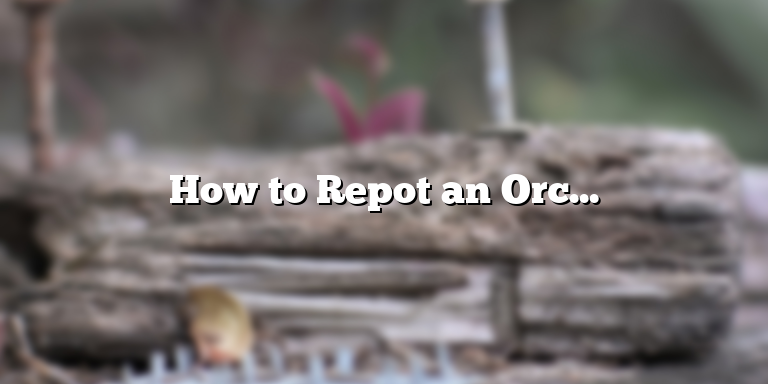
Preparing for Repotting
Repotting an orchid with air roots is vital if you want to ensure that your plant remains healthy and continues to thrive. Before you begin, you’ll need to have a few things in place, including a proper pot and growing medium, as well as a little bit of patience. Here are some steps to follow when getting ready to repot your orchid:
Selecting the Right Pot
Choose a pot that is the appropriate size for your orchid. If the pot is too small, it will restrict the growth of the roots and potentially damage the plant. If the pot is too large, it may retain too much moisture and lead to rot. The pot should have drainage holes to allow excess water to escape and be made of a material that allows for proper air circulation, such as terra cotta or a plastic pot with airflow.
Selecting the Right Growing Medium
The type of growing medium you use will depend on the type of orchid you have, but generally, orchids require a well-draining mix that is rich in nutrients. You can choose to use a pre-made orchid mix or create one yourself by combining materials such as coconut husks, perlite, bark, or sphagnum moss. Proper PH levels suitable for the specific species of orchid may also be a factor in choosing the right growing medium.
Soaking your Plant
Before transplanting your orchid into a new pot, it is advisable to soak it in water for 10-15 minutes. This process helps loosen the root system and makes it easier to work with. However, if your orchid has significant root rot or damage, this step should be avoided as much as possible.
By taking these preparatory steps, you will set your orchid up for success and ensure a smooth transition into its new pot.
Removing the Orchid from its Pot
When it comes to repotting an orchid with air roots, it’s essential to handle the plant carefully. Start by removing the orchid from its pot, being mindful of the air roots, which can be fragile. If the pot is plastic, you can often twist and gently pull on the sides to loosen the soil around the edges. Then, tilt the pot and gently support the base of the plant with your hand, easing it out of the container. If you encounter resistance, it may help to loosen the roots with a gentle tap or two against a hard surface, like the edge of a table or your workbench.
If the pot is too fragile or dense, you may need to cut it open with scissors or a blade. Cutting is tricky with an orchid because the air roots are exposed, but you can try gently wiggling a sharp blade around the edges and working your way toward the plant. You might also want to wear gloves when doing this to avoid damaging the roots or accidentally exposing yourself to any fungi or bacteria present in the soil.
As you begin the process, examine the pot for any signs of damage or decay, including soft spots, cracks, or areas of discoloration, which could be an indicator of rot. Be sure to dispose of the old pot properly. Once you have removed the orchid from its old container, it’s time to assess its root system and prepare it for the new pot.
Trimming the Air Roots
Repotting an orchid with air roots can be a bit intimidating, especially if you are worried about damaging the plant’s precious roots. But with a little bit of know-how, repotting your orchid can be a breeze. First and foremost, you will need to trim the air roots. Air roots are those roots that grow upwards towards the atmosphere, out of the potting mix. These roots are different from the terrestrial roots, which grow in the potting mix. Trimming the air roots is an important step in repotting an orchid, as it allows the plant to absorb more moisture and nutrients from the new potting mix.
When trimming the air roots, be sure to use a clean and sharp pair of scissors or pruning shears. Trim any damaged or rotten roots by cutting them off at the base. Avoid cutting healthy roots, as they are important for the plant’s survival. If you are unsure whether a root is healthy or not, simply leave it intact.
If your orchid has a lot of air roots, you may want to trim them in batches, rather than all at once. This will give the plant some time to adjust to the trimming and reduce the shock.
Remember, your orchid will need healthy roots to be able to absorb enough nutrients and moisture to grow and thrive. So it’s important to be gentle when trimming the air roots.
Once you have finished trimming, you can then move on to the next step in repotting your orchid. Whether you are doing this for the first time or as a routine maintenance, taking care of your orchid’s air roots will ensure that it continues to look stunning and healthy for years to come.
Repotting the Orchid
Repotting your orchid is an essential step in maintaining its health and ensuring its continued growth. However, if you notice that your orchid has air roots, you may be unsure how to proceed. Air roots are an essential part of an orchid’s survival and cannot be simply ignored in the repotting process. Fret not, we’ve got you covered!
Understanding Air Roots
The air roots you see on your orchid are not there by accident. They serve an essential purpose in the plant’s survival, helping it cling to trees or rocks in the wild, absorb moisture and nutrients from the air, and maintain its balance. In a pot, air roots can help your orchid absorb moisture and nutrients from the potting mix, but they need to be handled with care.
When to Repot an Orchid
Knowing when to repot an orchid is crucial to maintaining its health. Orchids need repotting when their potting mix starts to break down, which typically happens every twelve to eighteen months. Signs that it’s time to repot include yellowing leaves, stunted growth, and a general lack of vigor. If you notice any of these signs, it’s time to consider repotting your orchid.
Preparing to Repot an Orchid with Air Roots
Before repotting your orchid, you’ll need to prepare your potting mix, pots, and any tools you may need. If you are using a traditional potting mix, it’s essential to soak it before using it, as this will help prevent it from breaking down too quickly. You can also use an orchid-specific potting mix, which is less likely to break down over time. The most important thing is to take care not to damage your orchid’s air roots when repotting.
How to Repot An Orchid With Air Roots
Here’s a step-by-step guide to repotting your orchid with air roots:
- Remove the orchid from its old pot carefully.
- Gently remove any old potting mix from the roots, taking care not to damage the air roots.
- Inspect the roots for any signs of damage or disease. If you notice any, trim them off with a sterile pair of scissors.
- Place the orchid in its new pot, taking care not to bury the air roots. Add enough potting mix to keep the orchid in place and surround with more mix, patting down lightly to prevent any air pockets.
- Water the orchid thoroughly, making sure the potting mix is evenly moist.
Repotting an orchid with air roots may seem daunting, but with a little patience and care, your orchid will thrive in its new home.
In Conclusion
Repotting an orchid with air roots is essential for its health and continued growth. Remember to take care not to damage the air roots when repotting, and use an orchid-specific mix or a traditional mix that has been soaked beforehand. By following these simple steps, you can repot your orchid with confidence, knowing that you are providing it with the best possible environment for growth and vitality.
Aftercare
After repotting your orchid with air roots, it is important to provide it with the right care to ensure it thrives in its new environment. The following aftercare tips will help you keep your orchid healthy and happy:
1. Light
Orchids with air roots need bright, indirect light to thrive. Place your orchid near a window that receives filtered sunlight or use a grow light to provide the necessary light levels. Avoid placing your orchid in direct sunlight, as this can burn the leaves and cause damage to the plant.
2. Humidity
Orchids love humidity, and air roots depend on it to stay healthy. You can increase humidity levels by placing a tray of pebbles filled with water under your orchid or placing a humidifier in the room. Misting your orchid’s leaves with water can also help increase humidity levels, but be sure not to mist the flowers or buds as this can cause damage.
3. Water
The water requirements of your orchid with air roots will vary depending on the type of orchid and the environment. As a general rule, it is better to underwater your orchid than overwater it. When watering your orchid, make sure to use room-temperature water and avoid getting water on the leaves and flowers. Let the soil dry out between waterings, but don’t let it completely dry out or become too waterlogged.
4. Fertilizer
Orchids with air roots need regular feeding to stay healthy and produce beautiful flowers. Use a balanced orchid fertilizer and follow the instructions on the package for application rates. It is better to under-fertilize than over-fertilize, as too much fertilizer can damage the roots and leave your orchid vulnerable to disease.
5. Avoid Disturbance
After repotting your orchid with air roots, it is important to avoid disturbing the plant for a few weeks. This will give the orchid time to adjust to its new pot and environment. Avoid moving the plant, repotting it again, or touching the leaves and roots during this time. Once your orchid is established in its new environment, you can resume normal care.
By following these aftercare tips, you can keep your newly repotted orchid with air roots healthy and thriving. Remember to be patient and give your orchid time to adjust to its new environment, and you will be rewarded with beautiful flowers and healthy growth.






